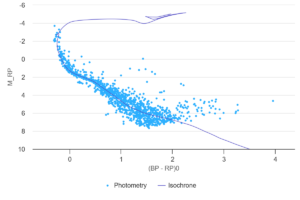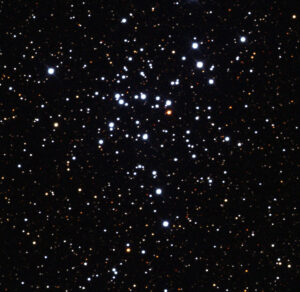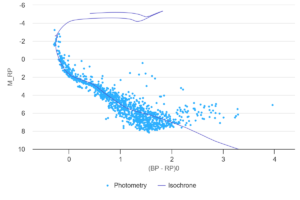NGC 4103 is a young open cluster in the Southern constellation of Crux and was discovered by the Scottish astronomer James Dunlop in the year 1826. The cluster is estimated to contain 421 members within its 12.1-15.9 parsec radius, with only 199 being in the central part of the cluster. The cluster is not heavily populated and primarily contains stars of the 10th magnitude and lower. Of these stars none are considered to be blue stragglers or red giants. The hottest stars in the cluster are of the spectral type B2.
In a recent study about understanding open clusters and broadening cluster membership by K Peña Ramírez et al (2022), one of the star clusters that they observed was NGC 4103. The study used the observational data from the VVV survey, which was a public survey scanning the milky way bulge alongside the southern mid plane in the near-infrared band. From this data set it stated that the star cluster NGC 4103 had around 190 members. By utilizing the data from the VVV survey and applying the Gaussian mixture models alongside unsupervised machine learning methods they were able to estimate that the cluster has closer to 438 members.
In order to study NGC 4103 and investigate the relationships between the colours, brightnesses, age and chemical composition of the cluster as a whole, I collected a total of 15 images using the Skynet Prompt 6 telescope located on Cerro Tololo in Chile. The images were taken using the B, R, and V band filters utilizing exposure lengths of 31.5, 23.62 and 11.81 seconds, respectively. Each of the filters had 5 pictures taken with spacing of over 1 hour between each image. I used Afterglow to stack, align and calibrate the images that I have taken, which is shown Figure 1.

After creating the tri-colour image of the NGC 4103 star cluster. I used Afterglow to gather the photometry data which was used as a input for Cluster Astromancer as the initial data source. In order to gather some results on the star cluster I completed some field star removal along with isochrone matching to create an isochrone model which can be seen in Figure 2. The isochrone model was then used to extract the details of the star cluster which are listed in the table below.

| Mass (solar) | Physical Radius (ly) | (RA, Dec) | Estimated Proper Motion (RA, Dec) (mas/yr) | Distance (kpc) | Age in years (Myrs) | Metallicity (solar) | E(B-V) (mag) |
| 47421.56 | 15.97 | (181.6°, -61.24°) | (-6.22, 0.23) | 1.27 | 56.26 | 0.35 | 0.31 |
Now that I have made my own observations along with my own isochrone model, I can begin to gain a better understanding of the NGC 4103 star cluster. One of the first things I did with the new data is create a dereddened photo (Figure 3) of the star cluster since I was able to calculate the reddening extinction value with the isochrone model. I can also look at Figure 2 and see that all the stars in the NGC 4103 cluster reside on the main sequence. There does not appear to be any blue stragglers, white dwarfs, or red giants on the graph.

The star cluster NGC 4103 was apart of the Milky Way Star Cluster Catalog (MWSC) and studied by Kharchenko et al (2013). This catalogue gathered data from clusters throughout our galaxy by estimating their parameters utilizing isochrone modelling. In their study they found the following values in the table below. I have compared these values to my own observations and calculation by creating an isochrone model which contains the values from the MWSC survey and they are displayed in Figure 4.
| Distance (kpc) | Log(Age (yrs)) | Metallicity (solar) | E (B-V) |
| 1.659 | 7.755 | N/A | 0.302 |

When comparing the two isochrone models, I believe that my measurements are slightly more accurate as they cause the isochrone model to follow the bottom of the main sequence rather than the MWSC’s measurements which cause the isochrone model to shift upwards slightly and display in the center of the main sequence of stars. The only major difference from our observations was the distance. I chose a value of 2.16 kpc and the MWSC observation chose closer to 1.66 kpc. It is also worth noting that the MWSC did not collect the cluster’s metallicity rating. I believe that my values could be used to help improve upon the previous results as the metallicity rating that I measured can affect the other cluster measurements.
Overall, this cluster project was an awesome experience as we got to work with real star clusters and see the whole process through from setting up the visual observations on Skynet to matching the isochrone model to the clusters main sequence of stars. We even had the opportunity to publish our findings on this blog site. I am grateful that our professor took the time to setup this project as it is something I will remember for the rest of my life!